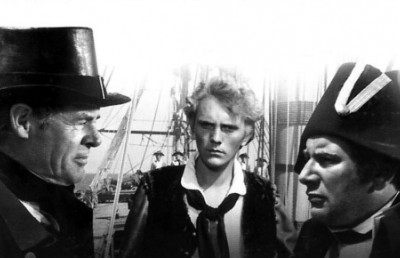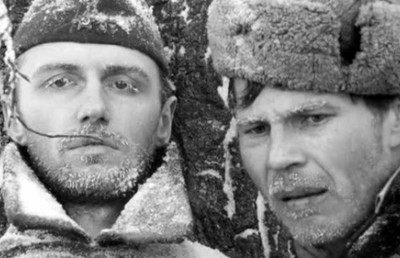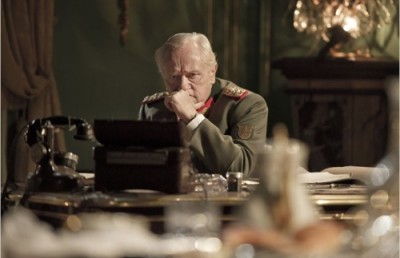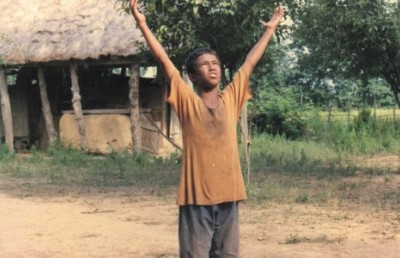The Hateful Eight (2015, Quentin Tarantino): The Big Show Returns
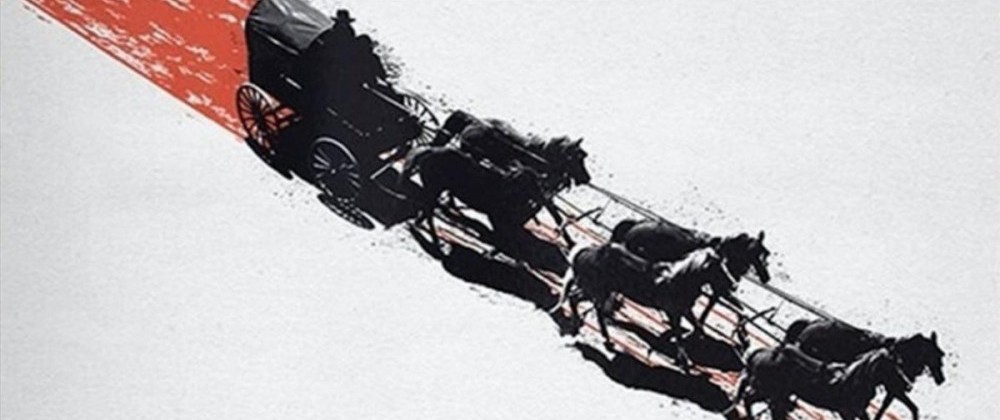
The term ‘Kammerspiel’ Western might be an apt description for Tarantino’s 8th film, which raises the bar on slow burn dramas that turn on narrative surprise and slippery character development. As westerns go it isn’t quite an anti-western but owes as much to Tarantino’s love of cinema as pure genre, this time seeing him blend the oldest American genre, the western, with elements of the mystery genre (in many respects it is a who dunnit), comedy, political intrigue, and even strains of the horror genre. In this latter respect, The Hateful Eight has much in common with the similarly minimalist-scored by Morricone film The Thing (1982), Carpenter’s slow-burn science-fiction/horror hybrid. Both films are set in snow bound locations during a bad storm, feature people forced to content with each other in cramped, claustrophobic spaces; feature Kurt Russell in a commanding role; one particular scene of high tension-fueled paranoia, and a similar conclusion which frames two survivors biding their time as death slowly envelopes them.
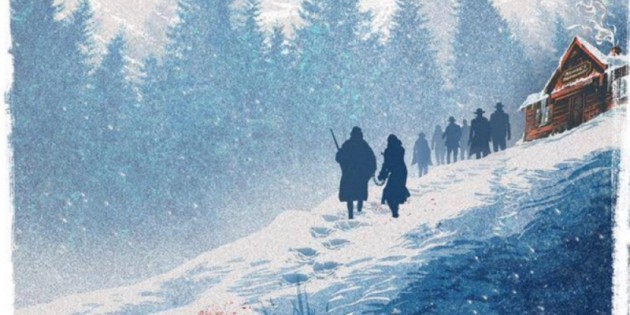
But the classic western is also part of Tarantino’s cultural warehouse of ideas, going as far back as the classic 1939 Stagecoach, which also includes long scenes in a stagecoach –_The Hateful Eight_ begins with a great long scene on a stagecoach bound on a snowy, desolate landscape– and features a varied group of people travelling together who are forced to interact under duress (Indian territory) and tight quarters of the varied way stations along their trip. Like in The Hateful Eight, the characters end up defying our first impressions, and people end up not being who they appear to be. The snow bound Wyoming setting recalls a handful of mostly great westerns set in wintry weather, The Great Silence, McCabe & Mrs. Miller, Day of the Outlaw, Track of the Cat, part of The Searchers, but also the cited non-western The Thing. Like the latter film, it is almost all men, seven out of the eight hateful people are men, but the single woman, Daisy Domergue, played with a light-hearted intensity by Jennifer Jason Leigh, more than holds her own as a hateful human against her seven male counterparts: her bounty hunter John Ruth (Kurt Russell), Major turned bounty hunter Marquis Warren (Samuel L. Jackson), new Sheriff of the area Chris Mannix (Walton Goggins), grizzled Southerner General Sandy Smithers (Bruce Dern), and fellow travelers Bob the Mexican (Demián Bichir), Joe Gage (Michael Madsen), and Oswaldo Mobray (Tim Roth). The film has received some criticism about its representation of the female lead being weaker than other Tarantino heroines, and held up to much physical punishment. I would argue that her character is strong nonetheless, within the restrictions of the script: after-all she is caught and in chains from the start. But as the film develops she slowly reveals snippets of what she was like before the plot began. She bides her time, looking and lurking with intent and purpose. The hierarchy of her gang is unclear but by the time her brother arrives to free her –his screen time being short– we get the sense that she may be the gang’s leader, along with her brother.
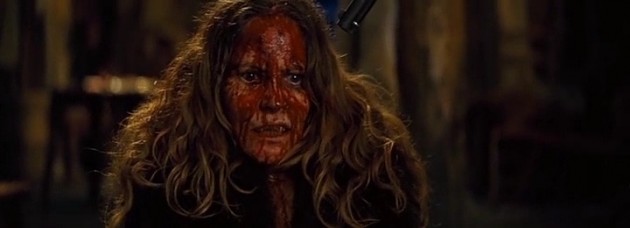
Daisy Domergue
A Tarantino film is always going to present a narrative twist, and this film’s structure includes one flashback that reverts to the proverbial “four hours before” title card which sets up the back-story leading to the film’s opening. In the end through a ‘catch-up’ flashback we learn that Joe Gage (Madsen), Oswaldo Mobray (Roth) and Bob the Mexican (Demian Bichir) are in league with Daisy Domergue’s brother Jody (Channing Tatum), determined to rescue her at all costs from the law. Major Marquis Warren finds them out by his intelligence, and they all die at the hands of Warren and the new sheriff Mannix, who themselves are fatally shot in the struggle. To achieve some sort of twisted poetic justice and honor John Ruth’s dictum of always hanging his quarry, Warren and Mannix manage to muster what little strength they have left out of their wounded bodies, and hang Daisy to her just end, and laugh their pain away as they await their inevitable death (noted allusion to The Thing).
As entertaining as any narrative twist, is the hilarious and very possibly fabricated flashback where Samuel L. Jackson’s snappy (Major Marquis Warren) goads an old Confederate general, played with brewing intensity by Bruce Dern, General Sandy Smithers, into a suicidal attempt at revenge over Warren’s implied torture and murder of his lone son. The scene is given added drama by the Mexican’s soulful piano rendition of “Silent Night”. Warren’s story concerns how he killed the general’s son Chester (the name Chester is also the name of W.C. Field’s son in the hilarious Klondike parody, A Fatal Glass of Beer, 1933, no doubt conscious on Tarantino’s part) by having him strip and walk nude in the freezing cold, as a revenge for the General’s own treatment of Northern Black prisoners. But Warren’s story does not stop at just killing the son, but debasing him, by embellishing the tale with the added bit that his son was so cold that he seeked the ‘warm’ blood inside Warren’s erect penis when it was offered to him. Only after this ‘rape’ does Warren kill him. The act, real or not, was Warren’s stated pay back for the General’s past act as “the bloody nigger killer of Baton Rouge” of not passing on proper wear provided by the Union for a band of Northern blacks who died from cold. This recounted story, which in its brazenness and shock value, recalls Christopher Walken’s long back story of the gold watch from Pulp Fiction, is an indicator of how Tarantino often treats racial themes in his films. It is clear with films such as Jackie Brown, Inglorious Bastards, and Django Unchained, that race, especially black-white race relations, is a narrative concern for Tarantino. In terms of its social message or whether his treatment of race is ‘positive’/‘liberal’ or ‘negative/reactionary’, my view is that Tarantino’s position on race is an extension of the 1970s Blaxploitation movement, which he himself is a fan of, in the sense of how those films gave the largely black audiences a strong, aggressive, sexualized black hero they could root for against white establishment. For many black viewers of the time who had experienced racism first hand, these Blaxploitation crime and action films were experiences in pure catharsis. Warren’s perverse vendetta story functions in a similar way for today’s audience’s, the difference being the historical North-South, Civil War context equalizes the race issue to include a black and white spectrum of viewers along more conventional political-ideological grounds (Liberal/Conservative, Democratic/Republican, Progressive/Reactionary).
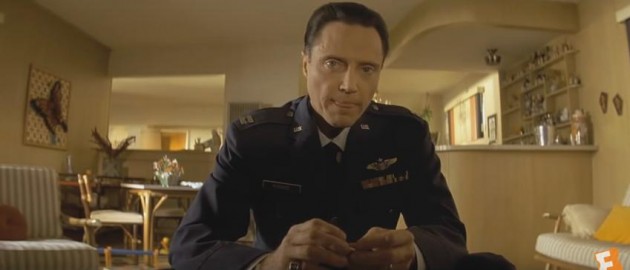
Walken’s tall ‘dirty’ golden watch story
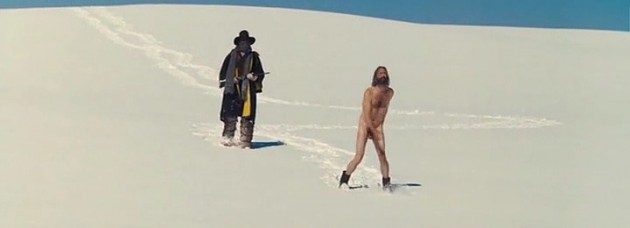
Chester Snowbound and cold
While this scene has both entertainment value and social import, there are other moments where Tarantino seems to be playing the social import card but only for the sake of pure entertainment. After a heated exchange between Northerner Warren and Southerners Sheriff Chris Mannix (Walter Goggins) and General Smithers (Bruce Dern), the hangman Oswaldo Mobray (Tim Roth) diffuses a possible escalation of anger by suggesting that the space of the cabin be split geo-politically along North-South lines. Ruth (Kurt Russell) agrees, “so long as the bar is on the Northern side!” Disappointingly, this intriguing premise is dropped like a hot poker and never incorporated into the plot, as characters walk through the cabin space with no consideration of hypothetical North-South border markings. My sense is that Tarantino just wanting to hear an actor of Tim Roth’s pedigree plow through this preposterous but funny solution to a racial problem (if only real racial problems were that easy to solve!). Warren’s noted long dialogue scene not only recalls Walken’s long flashback story about the ‘gold watch’ from Pulp Fiction, but Al Freeman Jr.‘s angry racialist-driven monologue in the incendiary drama Dutchman (1967, Anthony Harvey). In one of the film’s key ‘social conscious’ scenes Roth’s hangman articulates the thin line between legal justice and frontier justice, with the line separating the two being himself, the presence of the hangman, largely because the hangman approaches the task with “no emotional dispatch”. The film goes further by laying out different aspects of both. Red Rock’s newly forming legal body is one form of justice, and that is upheld by Hangman John Ruth, who is adamant that he bring in his criminals alive so they can hang ‘legally’. But Warren, arguably the film’s protagonist, is an emblem of frontier justice, so that a lie (his famous letter from Abraham Lincoln) and fabrication or embellishment (the story he tells General about his son) is alright by him so long as it leads to justice (the letter he claims, cuts him some racist slack) or justified revenge as he sees it (killing General Smithers for his past sins against black soldiers). Granted its many nods to social commentary, The Hateful Eight gives way to human greed and ‘frontier’ rectitude, including a bloody climax that sends the film into gore gag territory: Warren blows two barrels into a man’s head, blowing it to smithereens; poisoned coffee sends its victims spewing blood profusely; and well aimed gun shots up through the floorboard maim Warren in his private parts (retaliation for his flashback story?).
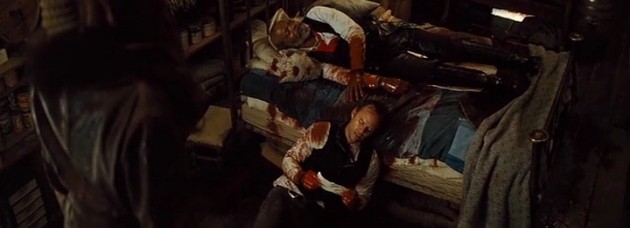
Perhaps the greatest stunt Tarantino pulled off for The Hateful Eight was convincing everyone involved to shoot this film in a super wide format (2.76.1) which had not been used since 1966, and at that for only ten feature films. 1 All of the ten features made in Ultra Panavision 70mm were films of grand epic proportion, like Khartoum, the last film in this format, 1966, Ben Hur, It’s a Mad, Mad, Mad, Mad World, and Mutiny on the Bounty, which filmed spectacles with large casts, adventure and grand locations. Outside of the opening 40 or so minutes, which are filmed on location in the snowy mountains of Wyoming, the film takes place inside a single location, a roomy cabin in the middle of nowhere. Granted the opening scenes, especially the shots from the moving coach, are the most staggeringly beautiful of the film; but then once inside the spacious “Minnie’s Haberdashery” it is all about framing, composition and back/foreground interactions. And cinematographer Tony Richardson notes that the 70mm format “works beautifully for intimate close-ups, and lauds its ability to capture the ‘landscape’ of the human face” (Michael Goldman, 37). It seems only natural that Tarantino, a director who loves working with actors and writing them dialogue that snaps, crackles and pops, would shift the onus from natural landscape to human landscape. With such a wide ratio, even close-ups afford space for elements of the mise en scene to be visible, whether other characters, set design, or props. The wide framing allows for close-up and long shots to co-exist, often framed in dramatic diagonals, like the moment where Mannix realizes who General Smithers is. When Warren plots his tall tale to seduce General Smithers, the General is in the far left foreground and Warren in the right background at the bar. Smithers, who stays glued to his chair the whole film, acts like a fulcrum point for Tarantino’s compositions.
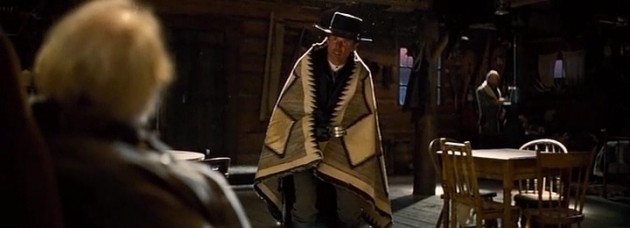
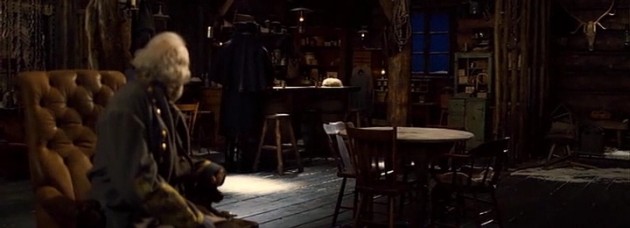
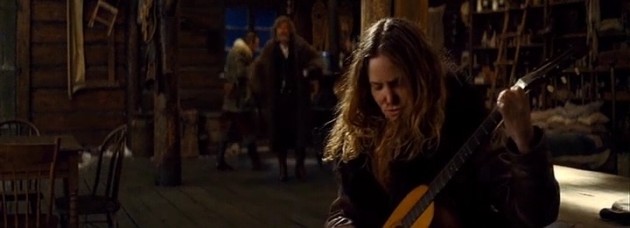
Daisy’s solo guitar ballad is played compositionally with her in the right foreground and John in the back or middleground. Most of the song is played in one long take, with the image rack focusing between John and Daisy. Tarantino also makes great use of the split-diopter to attain great focus within extremes of composition, adding a visual clarity where there is none otherwise (character, morality, politics, etc.). The use of wide angle lens makes the cabin space seem larger than life, as in this shot where the distance between the front door and the middle of the room feels like a vast void.
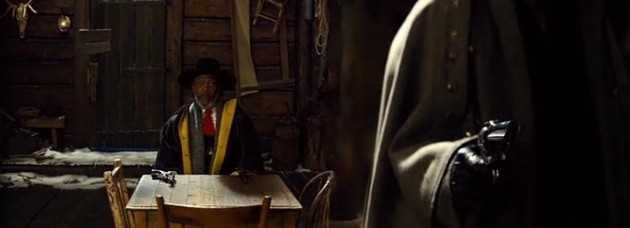
Split-diopter clarity (where spatial extremes are kept in crisp focus)
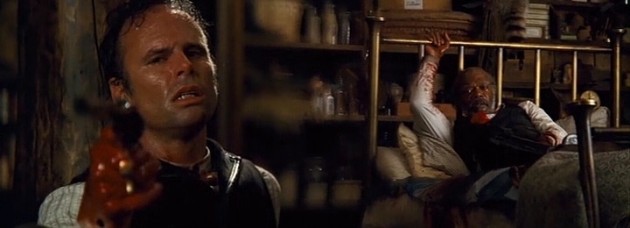
Split-diopter clarity
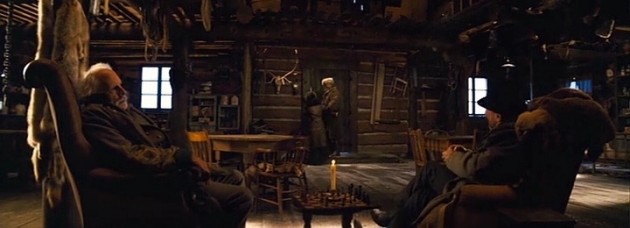
Expansive space
The opening scene of the film includes a shot which begins close-up on the face of a Christ statue, then cranes back to reveal a baroque wooden cross, planted in the middle of the snowy landscape (referred to as “Jesus Road” in the American Cinematographer article). My first thought was how odd it was to find this ode to Christianity christening the opening of a film which features some of the most ‘un-Christian’ like behavior ever committed to cinema. Granted the western and religion are no strange bedfellows, as Christ figures, churches, and redemption journeys are common subjects in the western. But on second viewing I noted a subtle visual motif that echoes back to the opening Christ on the Cross. Bounty Hunter John Ruth’s marker was that he always brought his quarry in alive, so that the newly found justice can be parceled out correctly and the victim hung for his or her crimes. Although Ruth is dead before the final scene, Warren and Mannix pay him homage by hanging Domergue, rather than letting her die a slow death or be caught by another bounty hunter. Domergue has been for the most part of the film a bit of a punching bag, and meets her anointed end, at the end of a noose. As she is dying, we get a shot of her hanging body from the point of view of the two men who hoisted her up to her death, Warren and Mannix. But the attentive viewer will catch the symbol of the shot if they look into the background, where two snowshoes on the wall behind Domergue are strategically placed at 45 degree angles and lined up with her shoulders. The effect is to make her look like an angel, or indeed, a Christ-like figure, sacrificed for the benefit of the new justice system. The opening shot of Christ on the cross takes on a different flavor, forming a book-end with the image of Domergue framed with her angel wings. Tarantino includes other little touches that render their meaning on a second viewing, like the early overhead shot above the ceiling in the cabin which, in calling attention to itself, foreshadows the revelation of Daisy’s brother hiding out in the basement.
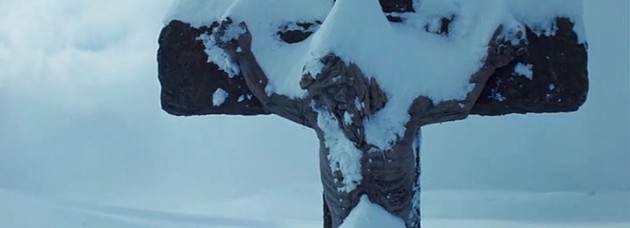
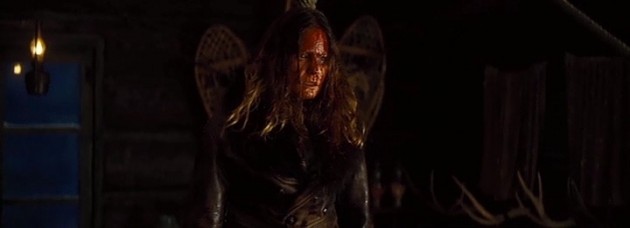
Daisy Domergue as a Christ-like ‘angelic’ figure
In the city where I saw The Hateful Eight, Montreal, Tarantino’s ‘Roadshow’ spectacle has proven a huge success. The percentage of screenings that were sold out was so high that they added several extra weeks to the planned two week run. The theatre where I saw the film twice, Theater Banque Scotia, ran out of the souvenir programs after the first packed Christmas weekend. Luckily my good friend Randolph Jordan also saw the film at the Landmark theatre in Los Angeles, and was able to score a few extra programs, one of which went my way. Tarantino is not the only celluloid hold-out during these recent times. We know all about Christopher Nolan’s staunch defense of film; but veteran director Todd Haynes shot Carol in Super 16mm, blown to 35mm, actor turned director Joseph Gordon-Levitt’s Don Jon, J.J. Abrahams’ Star Wars Episode VII, the Coen Bros. Inside Llewyn Davis, and Silver Linings Playbook by David O. Russell were all shot on celluloid. And rookie director László Nemes persisted on shooting Son of Saul in 35mm and in old school full Academy ratio, 1.33:1; and Nemes was rewarded with an Academy Award for Best Foreign film of 2015. All of this goes to show that, to paraphrase Mark Twain, “the reports of the death of celluloid are greatly exaggerated.”
The Feature image is taken from the very useful official The Hateful Eight website:
Bibliography
B. Benjamin. “Reviving Ultra Panavision 70mm”. The American Cinematographer, Vol. 96, Issue 12, December 2015, 46.
Goldman, Michael. “Wide, Wide West.” The American Cinematographer, Vol. 96, Issue 12, December 2015, 36-51.
Notes
- According to the article on the film in The American Cinematographer, December 2015, p. 37. ↩



